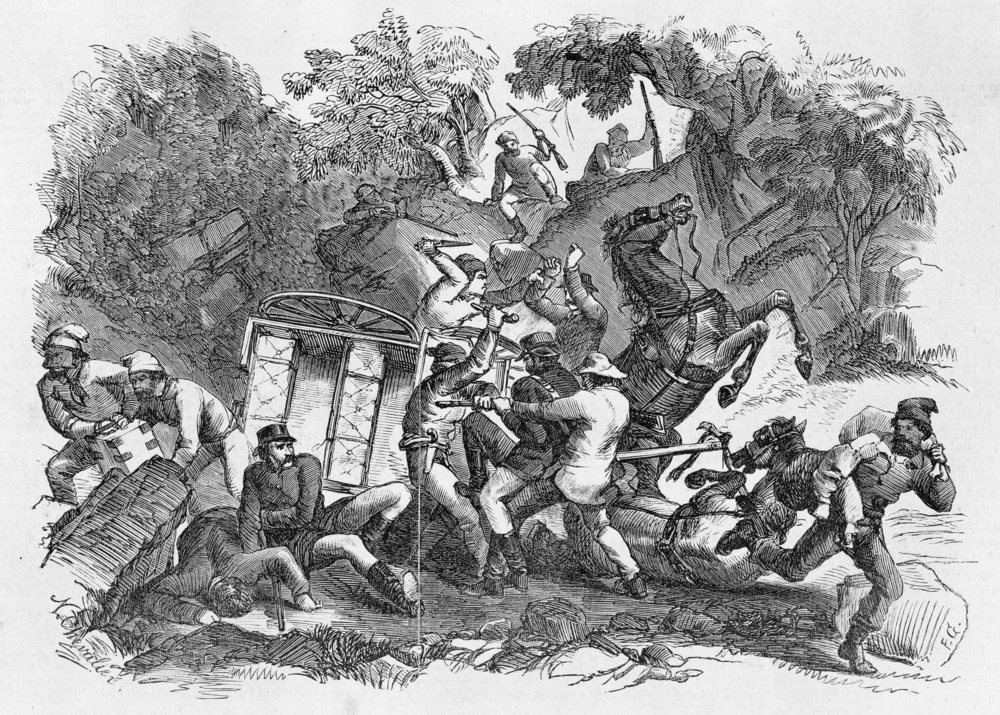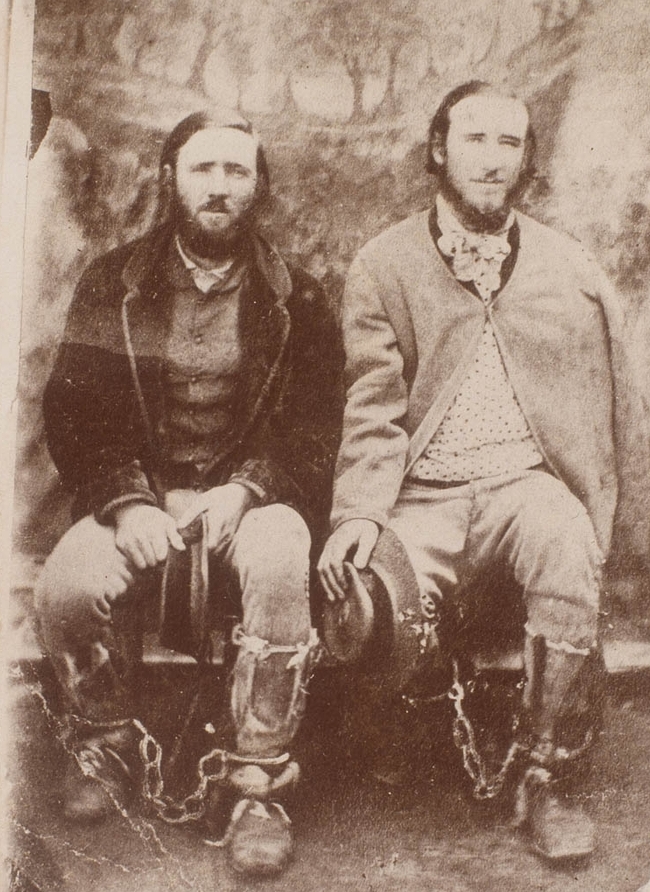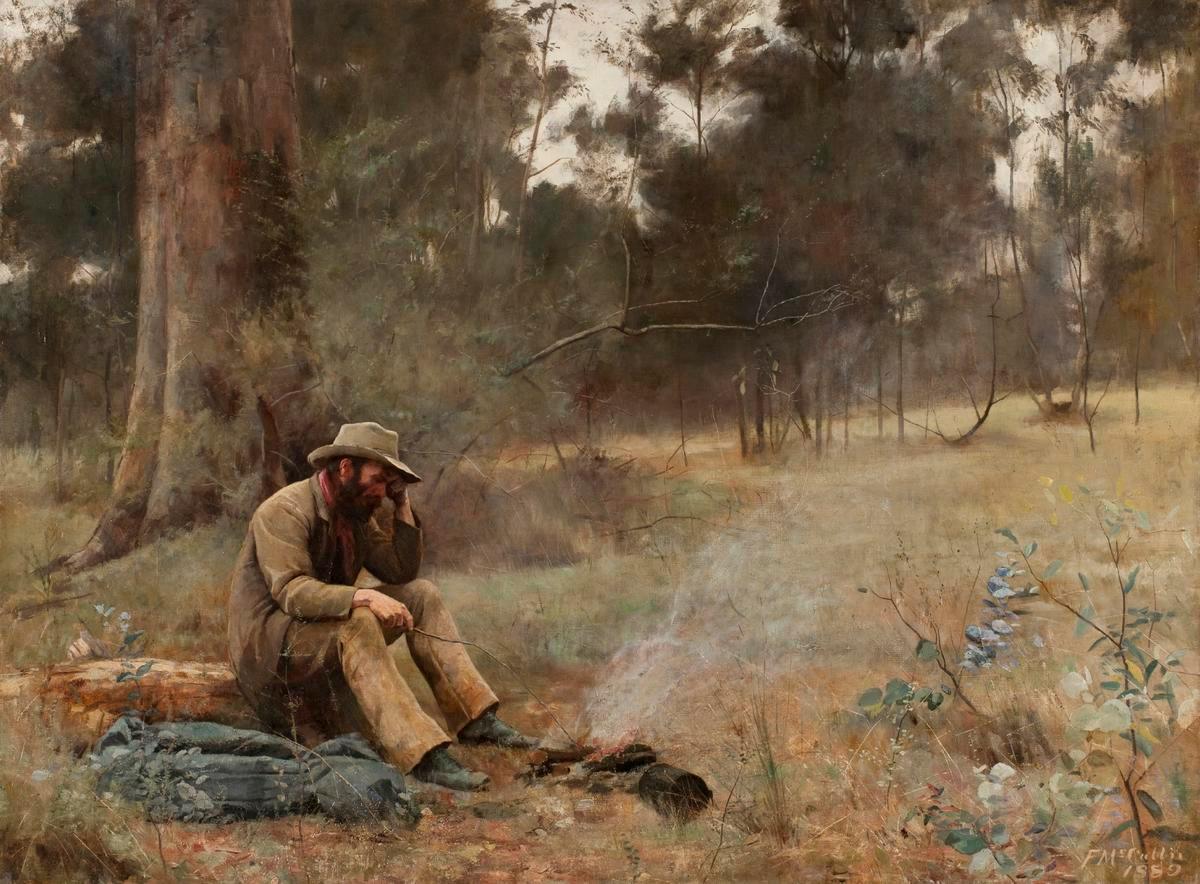|
Bushranger
Bushrangers were armed robbers and outlaws who resided in The bush#Australia, the Australian bush between the 1780s and the early 20th century. The original use of the term dates back to the early years of the British colonisation of Australia, and applied to convicts in Australia, transported convicts who had escaped into the bush to hide from the authorities. By the 1820s, the term had evolved to refer to those who took up "armed robbery, robbery under arms" as a way of life, using the bush as their base. Bushranging thrived during the mid-19th century Australian gold rushes, gold rushes, with many bushrangers roaming the goldfields and country districts of New South Wales and Victoria (state), Victoria, and to a lesser extent Queensland. As the outbreak worsened in the mid-1860s, colonial governments outlawed many of the most notorious bushrangers, including the Gardiner–Hall gang, Dan Morgan (bushranger), Dan Morgan, and the Clarke gang. These "The Wild Colonial Boy, Wild ... [...More Info...] [...Related Items...] OR: [Wikipedia] [Google] [Baidu] |
Dan Morgan (bushranger)
John Owen (30 April 18309 April 1865), better known by his alias Daniel Morgan, was an Australian bushranger and outlaw. Active mainly in the Riverina of New South Wales and northern Victoria, he committed numerous raids and robberies and murdered at least four men, including two constables. He also shot several others. Morgan was known by multiple aliases during his bushranging career, including Billy the Native, Warrigal and Down-the-River Jack. After Morgan wounded police magistrate Henry Baylis in a shootout in August 1863, the Government of New South Wales offered a reward for his capture. The amount increased to £1,000 as his crimes escalated, and he was officially declared an outlaw in March 1865. One month later, while holding up Peechelba station in Victoria, he was shot and killed by a stockman. Many accounts of Morgan, particularly in the years after his death, depict him as bloodthirsty, erratic and insane, inspiring his posthumous sobriquet, Mad Dog Morgan. ... [...More Info...] [...Related Items...] OR: [Wikipedia] [Google] [Baidu] |
Ned Kelly
Edward Kelly (December 185411 November 1880) was an Australian bushranger, outlaw, gang leader, bank robber and convicted police-murderer. One of the last bushrangers, he is known for wearing armour of the Kelly gang, a suit of bulletproof armour during his final shootout with the police. Kelly was born and raised in rural Colony of Victoria, Victoria, the third of eight children to Irish parents. His father, a Convicts in Australia, transported convict, died in 1866, leaving Kelly, then aged 12, as the eldest male of the household. The Kellys were a poor selection (Australian history), selector family who saw themselves as downtrodden by the squattocracy and as victims of persecution by the Victoria Police. While a teenager, Kelly was arrested for associating with bushranger Harry Power and served two prison terms for a variety of offences, the longest stretch being from 1871 to 1874. He later joined the "Greta, Victoria, Greta Mob", a group of Australian bush, bush larrik ... [...More Info...] [...Related Items...] OR: [Wikipedia] [Google] [Baidu] |
Gardiner–Hall Gang
The Gardiner–Hall Gang was an informal group of bushrangers who roamed the central west of the Colony of New South Wales, Australia in the 1860s. Named after leaders Frank Gardiner and Ben Hall (bushranger), Ben Hall, the gang was involved in numerous shootouts and robberies, including Australia's largest ever gold robbery, at Eugowra, New South Wales, Eugowra Rocks. The gang formed in 1861 and its demise came with the execution of John Dunn (bushranger), John Dunn in 1866. Several members of the gang, in particular Ben Hall, have become prominent figures in Australian folklore, inspiring numerous songs, films, plays and other cultural depictions. Known members and fate *John Bow: sentenced to death, later commuted to fifteen years in prison *Michael Burke (bushranger), Michael Burke: Suicide, committed suicide via gunshot after receiving being shot in the stomach *Dan Charters: caught, testified against the gang *John Connors: one of the "Three Jacks" *Larry Cummins (bushran ... [...More Info...] [...Related Items...] OR: [Wikipedia] [Google] [Baidu] |
Clarke Gang
The Clarke gang was a group of bushrangers active in the mid-1860s in the southern goldfields of New South Wales, Australia. The membership of the gang fluctuated over time, the two core members being brothers Thomas and John Clarke, from the Braidwood, New South Wales, Braidwood district. The Clarke brothers, along with several relatives and associates, were responsible for a reported 71 robberies and hold-ups, as well as the death of at least one policeman; they are also the primary suspects in the killing of a squad of four policemen sent to capture them. The gang also shot several others, four of whom died from their wounds, including one gang member and a man they wrongly assumed was a police tracker. Their crimes formed part of a bushranging epidemic that inspired the Government of New South Wales to enact the ''Felons' Apprehension Act'' (1866), a law that introduced the concept of outlawry in the colony and authorised citizens to kill bushrangers on sight. Thomas was proc ... [...More Info...] [...Related Items...] OR: [Wikipedia] [Google] [Baidu] |
Convicts In Australia
Between 1788 and 1868 the British penal system transported about 162,000 convicts from Great Britain and Ireland to various penal colonies in Australia. The British Government began transporting convicts overseas to American colonies in the early 18th century. After trans-Atlantic transportation ended with the start of the American Revolution, authorities sought an alternative destination to relieve further overcrowding of British prisons and hulks. Earlier in 1770, James Cook had charted and claimed possession of the east coast of Australia for Britain. Seeking to pre-empt the French colonial empire from expanding into the region, Britain chose Australia as the site of a penal colony, and in 1787, the First Fleet of eleven convict ships set sail for Botany Bay, arriving on 20 January 1788 to found Sydney, New South Wales, the first European settlement on the continent. Other penal colonies were later established in Van Diemen's Land (Tasmania) in 1803 and Queensland in 18 ... [...More Info...] [...Related Items...] OR: [Wikipedia] [Google] [Baidu] |
The Wild Colonial Boy
"The Wild Colonial Boy" ( Roud 677, Laws L20) is a traditional anonymously penned Irish-Australian folk ballad that tells the story of a bushranger in early colonial Australia who dies during a gunfight with local police. Versions of the ballad give different names for the bushranger involved: some based on real individuals and some apparently fictional. A common theme is romanticisation of the bushranger's battle against colonial authority. According to a report in '' The Argus'' in November 1880, Ann Jones, the innkeeper of the Glenrowan Hotel, asked her son to sing the ballad when the Kelly Gang were at her hotel in June that year. Identity of the bushranger Versions of the ballad depict bushrangers with the first name of "Jack" and surnames such as "Dolan," "Doolan," "Duggan" and "Donahue." It is unclear if the ballad originally referred to an actual person. One possible origin is Jack Donahue (also spelled Donohoe), an 1820s Irish convict who was sent to Australia, beca ... [...More Info...] [...Related Items...] OR: [Wikipedia] [Google] [Baidu] |
The Bush
"The bush" is a term mostly used in the English vernacular of Australia, New Zealand and South Africa, where it is largely synonymous with hinterlands or backwoods. The fauna and flora contained within the bush is typically native to the region, although exotic species may also be present. The expression has been in use in Australia from the earliest years of British settlement, and it has inspired many derivative Australian English terms, such as bush tucker, bush ballad and bushranger. The term is also widely used in Canada and the American state of Alaska to refer to the large, forested portions of their landscapes. Usage by country Australia The concept of "the bush" has become iconic in Australia. In reference to the landscape, "bush" refers to any sparsely inhabited region, regardless of vegetation. "The bush" in this sense was something that was uniquely Australian and very different from the green European landscapes familiar to many new immigrants. The term "Outba ... [...More Info...] [...Related Items...] OR: [Wikipedia] [Google] [Baidu] |
Highwayman
A highwayman was a robber who stole from travellers. This type of thief usually travelled and robbed by horse as compared to a footpad who travelled and robbed on foot; mounted highwaymen were widely considered to be socially superior to footpads. Rid, Samuel. "Martin Markall, Beadle of Bridewell," in ''The Elizabethan Underworld'', A. V. Judges, ed. pp. 415–416. George Routledge, 1930Online quotationSpraggs, pp. 107, 169, 190–191. Such criminals operated until the mid- or late 19th century. Highwaywomen, such as Katherine Ferrers, were said to also exist, often dressing as men, especially in fiction. The first attestation of the word ''highwayman'' is from 1617. Euphemisms such as "knights of the road" and "gentlemen of the road" were sometimes used by people interested in romanticizing (with a Robin Hood–esque slant) what was often an especially violent form of stealing. In the 19th-century American West, highwaymen were sometimes known as road agents. In Australia, ... [...More Info...] [...Related Items...] OR: [Wikipedia] [Google] [Baidu] |
Outlaw
An outlaw, in its original and legal meaning, is a person declared as outside the protection of the law. In pre-modern societies, all legal protection was withdrawn from the criminal, so anyone was legally empowered to persecute or kill them. Outlawry was thus one of the harshest penalties in the legal system. In Germanic law, early Germanic law, the death penalty is conspicuously absent, and outlawing is the most extreme punishment, presumably amounting to a death sentence in practice. The concept is known from Roman law, as the status of ''homo sacer'', and persisted throughout the Middle Ages. A secondary meaning of outlaw is a person systematically avoiding capture by evasion and violence. These meanings are related and overlapping but not necessarily identical. A fugitive who is declared outside protection of law in one jurisdiction but who receives asylum and lives openly and obedient to local laws in another jurisdiction is an outlaw in the first meaning but not the seco ... [...More Info...] [...Related Items...] OR: [Wikipedia] [Google] [Baidu] |
National Museum Of Australia
The National Museum of Australia (NMA), in the national capital Canberra, preserves and interprets Australia's social history, exploring the key issues, people and events that have shaped the nation. It was formally established by the ''National Museum of Australia Act 1980''. The museum profiles 50,000 years of Indigenous heritage, settlement since 1788 and key events including Federation of Australia, Federation and the Sydney 2000 Olympics. It holds the world's largest collection of Aboriginal Australians, Aboriginal bark paintings and stone tools, the heart of champion racehorse Phar Lap and the Holden prototype No. 1 car. The museum also develops and travels exhibitions on subjects ranging from bushrangers to surf lifesaving. The National Museum of Australia Press publishes a wide range of books, catalogues and journals. The museum's Research Centre takes a cross-disciplinary approach to history, ensuring the museum is a lively forum for ideas and debate about Australia's ... [...More Info...] [...Related Items...] OR: [Wikipedia] [Google] [Baidu] |
Glenrowan, Victoria
Glenrowan is a town located in the Wangaratta local government area of Victoria, Australia. It is 236 kilometres north-east of Melbourne and 14 kilometres from Wangaratta and near the Warby Ranges and Mount Glenrowan. At the , Glenrowan had a population of 1,049. History Glenrowan was named after farmers James and George Rowan who ran farms in the area between 1846 and 1858. The township was settled in the late 1860s, the Post Office opening on 22 February 1870. It is famous for the bushranger Ned Kelly, who made his last stand and was eventually captured there in 1880 after a siege and shootout with police. The local railway station opened in 1874 and closed to passengers in 1981. The town gives its name to the Glenrowan wine region which was formally defined in 2003, with the first grape vines planted in 1866. The town today Glenrowan is a popular rest point for those travelling on the Hume Freeway. In the township of Glenrowan, off the highway, tourists c ... [...More Info...] [...Related Items...] OR: [Wikipedia] [Google] [Baidu] |
Hawkesbury, New South Wales
The City of Hawkesbury is a local government area that is located on the far northwest fringe of the Greater Sydney area in New South Wales, Australia. The local government area is located in the Hawkesbury and Blue Mountains regions. Hawkesbury City is named after the Hawkesbury River. Major suburbs in the City of Hawkesbury are Windsor, Richmond and Pitt Town. It is a member council of the Hawkesbury River County Council. The mayor of the City of Hawkesbury is Cr. Les Sheather, an independent associated with the Liberal Party. Suburbs and localities in the local government area Suburbs and localities in the City of Hawkesbury are: History The original inhabitants of the Hawkesbury district were the Darug tribe of Aboriginals, also spelt as Dharug or Daruk. The river, which they called Derrubbin, was a focal point as a source of food and transport. The Darug people used the river to farm for fish, eels, water birds, and mussels. They also used the river as a mode of t ... [...More Info...] [...Related Items...] OR: [Wikipedia] [Google] [Baidu] |










